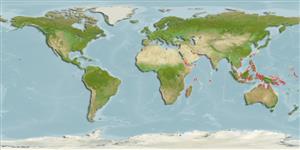Teleostei (teleosts) >
Anguilliformes (Eels and morays) >
Ophichthidae (Snake eels) > Myrophinae
Etymology: Neenchelys: Name from Greek 'neo' for new and 'enchelys' for eel.
Eponymy: Pieter Buitendijk (1870–1932) was a ship’s surgeon, mainly on steamers trading between Amsterdam and Java. [...] (Ref. 128868), visit book page.
More on authors: Weber & deBeaufort.
Environment: milieu / climate zone / depth range / distribution range
Ecology
Marine; demersal; depth range 2 - 3 m (Ref. 96531). Tropical
Indo-West Pacific: India, Indonesia and western Malaysia. Also reported from Pakistan and Vietnam.
Size / Weight / Age
Maturity: Lm ? range ? - ? cm
Max length : 30.0 cm TL male/unsexed; (Ref. 7245)
Short description
Identification keys | Morphology | Morphometrics
This species is distinguished by the following characters: body robust, its depth 19-32 times in TL; head length (HL) 7.8-8.5 in TL; pointed snout; well developed pectoral fin, which is longer than snout, 4.0-4.8 in HL; origin of dorsal fin relatively forward, 0.4-0.5 times HL behind gill opening; predorsal length 5.7-6.0 in TL; large gill opening, its height 6.8-8.5 in HL; teeth conical, slender, uniserial in jaws and vomer; total vertebrae 135-148; MVF 19-50-140; single median temporal and interorbital pores; supraorbital pores 1 + 4; infraorbital pores 5 + 1 (1 or 2 pores between anterior and posterior nostrils); mandibular pores 7; preopercular pores 2; supratemporal pores 3; cephalic lateral line pores 13 or 14; predorsal pores 20-22; preanal pores 51-54; when preserved specimens are pale brown dorsally and paler ventrally, with black posterior portions of dorsal and anal fins (Ref. 96531).
A small, burrowing eel which is active over soft sediments at night.
Life cycle and mating behavior
Maturity | Reproduction | Spawning | Eggs | Fecundity | Larvae
Ho, H.-C., J.E. McCosker and D.G. Smith, 2013. Revision of the worm eel genus Neenchelys (Ophichthidae; Myrophinae), with descriptions of three new species from the western Pacific Ocean. Zoological Studies 52(58):1-20. (Ref. 96531)
IUCN Red List Status (Ref. 130435: Version 2024-2)
Threat to humans
Harmless
Human uses
Fisheries: minor commercial; bait: usually
Tools
Special reports
Download XML
Internet sources
Estimates based on models
Preferred temperature (Ref.
123201): 26.5 - 29.1, mean 28.5 °C (based on 1236 cells).
Phylogenetic diversity index (Ref.
82804): PD
50 = 0.5020 [Uniqueness, from 0.5 = low to 2.0 = high].
Bayesian length-weight: a=0.00076 (0.00029 - 0.00197), b=3.06 (2.83 - 3.29), in cm total length, based on LWR estimates for this (Sub)family-body shape (Ref.
93245).
Trophic level (Ref.
69278): 4.0 ±0.7 se; based on size and trophs of closest relatives
Resilience (Ref.
120179): High, minimum population doubling time less than 15 months (Preliminary K or Fecundity.).
Fishing Vulnerability (Ref.
59153): Low vulnerability (20 of 100).
